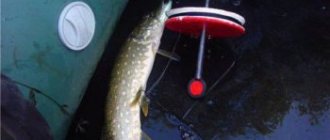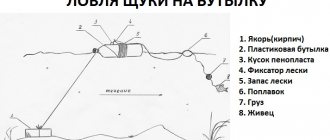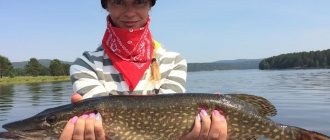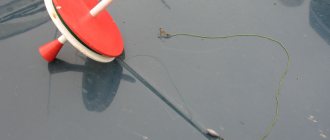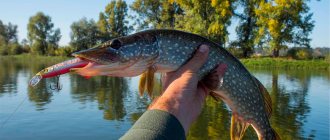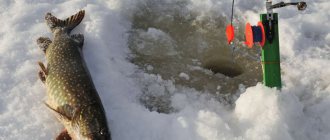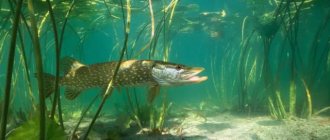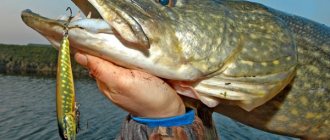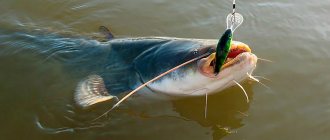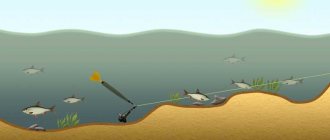Equipment for pike fishing circles
Equipping the circles should not cause difficulties for a person more or less familiar with fishing. As a rule, it is more practical and easier to equip purchased ones, although nothing prevents you from making them yourself.
Standard circle
A standard circle is made of polystyrene foam 20–30 mm thick, 15 cm in diameter, with a groove at the end and a 15 cm long mast.
To collect the gear you will need:
- a circle with a mast-pin;
- main cord or fishing line 0.25 - 0.45 mm, slightly longer than the depth of the reservoir at the fishing site;
- fishing line 1.8 - 2.5 mm, on a retractable leash, up to a meter long;
- steel leash 20 – 30 cm, with carabiner;
- sliding sinker;
- swivel
Equipping circles for pike fishing
We decide how we want to equip the circle, for mobile fishing (so that it floats freely) or stationary. In the second case, you can take any weight instead of a sliding load, and you will additionally need a pair of stoppers.
Free floating circle
We equip a free-floating circle as follows:
- Using a regular loop, attach the main fishing line or cord to the foam circle and wind it into the groove at the end;
- We put a sliding weight on the other end and tie a swivel;
- We attach a thinner leash 0.5 - 1 m long to the swivel so that the baitfish feels freer;
- We attach a steel leash with a hook to this leash;
- The tackle is ready.
Important! When attacking live bait, the pike first grabs it across the body, and then turns its head into its mouth to swallow it, take this into account when baiting.
To place the mug permanently, we do it a little differently:
- After winding the main cord, we put one eye of the swivel on it;
- We knit a weight to the end of the cord;
- We limit the sliding of the swivel along the cord on both sides with a pair of stoppers, determining at what depth the bait will be;
- Next, as in the previous case, we knit leashes with a hook to the swivel.
With the first type of equipment, the circles can work both in motion and motionless, with the second only motionless.
Video: Equipping a mug for pike fishing
DIY mugs for pike from a bottle
This type of circles has not found wide application, but has the right to life.
Making such a circle will not be difficult; here is the procedure for preparing such a circle:
- A fishing line or braided thread is tied to the neck of a plastic bottle with a capacity of at least 0.5 liters, preferably one that already has a narrowing in the middle, and is wound around the bottle. The length is selected according to the same principle as in classic mugs.
- The mug is being rigged (sinker, hook leash)
- After the bait is hooked and lowered into the water to the required depth, the fishing line is fixed to the bottle by inserting several loops under a rubber ring. That's it, our gear works. After the bite occurs, the pike will pull the line out from under the rubber ring and begin to reel it in; as soon as all the line is reeled in, the bottle will rise upside down. In order to make the bite more noticeable, it is better to paint the bottom of the bottle (in our case, the bottom) in a bright color with waterproof paint.
The mugs used for pike fishing must be the same size, especially in thickness. For ease of transportation and storage of mugs, the mast does not need to be tightly attached to the mug. And we must remember that the success of pike fishing depends on many factors, including knowledge of the reservoir, the ability to choose the right tackle and bait, as well as the personal qualities of the fisherman.
Installation on the current
The most common installation method is to place free-floating circles. It allows, in the presence of a current or wind, to fish a fairly large area of the reservoir. When installing on a current, the angler must know its strength and direction, the depths and topography of the bottom in the place of fishing, and decide at what depth he will place the live bait. For this method of fishing, equipment of the first type is used.
Now let’s figure out how to correctly place the circles in this way:
- We unwind the required amount of main fishing line.
- We pass it through the cut at the end of the foam circle, wrap it around the mast several times, and then
- We pin it into the slot at its top.
- We bait with live bait.
- We lower the live bait into the water, followed by a fishing line with a circle.
- The gear is installed, let's move on to installing the next one.
At anchor
A fixed circle setup is used when it is necessary to fish either a specific place, or its movement will be hampered by the bottom topography, abundant vegetation or snags. In this case, we use circles with equipment of the second type, where a load tied from below will act as an anchor.
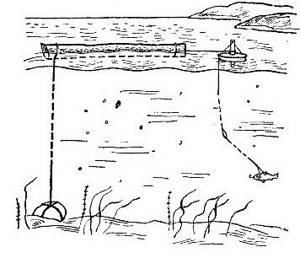
Installation in still water
They are placed like this:
- We rewind the main line to the depth of the bait.
- Using stoppers, we set on the main line the depth from the bottom at which the bait will be.
- We hook on live bait.
- We send the tackle overboard and release the main line before the load touches the bottom.
- leaving an additional half meter of the main cord for some freedom, we pass the cord into the groove at the end and pin it at the top of the mast, after which we lower the circle into the water.
This installation method has a number of disadvantages. A weight dragging along the bottom after a bite can scare away the pike. In strong winds or waves, the circle will turn over on itself.
Stationary without anchor
Installation by attaching the mug itself to surface objects using a piece of cord or fishing line helps to avoid the disadvantages described above. These can be coastal bushes, tree branches, reeds, snags protruding from the water. For fastening, you can use a floating anchor; to do this, light a board, a piece of foam plastic or another float afloat, and then tie a circle to it. We secure it by tying a cord around the lower, wide part of the mast, protruding from the back side. In this case, after turning the mug over, it will not interfere with the free flow of the fishing line.
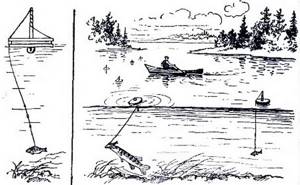
Mugs on the water
We place the mugs themselves in the same way as they do when placed freely in the current, but before they are released, they are tied to the above-mentioned objects.
Fishing technique or where to place the mugs
If fishing is carried out in the spring, after the ice has melted, then you should look for pike in grassy and snagged places where the fish spawn. After 2 weeks, the predators change their location and move into holes and rifts. The feeding starts, you can fish all day.
In the summer, pike is in search of food, swimming near reeds, snags, and in any places where there is an opportunity to set up an ambush. Water lilies are growing - this is a plus; the pike will mistake the installed mugs for water lily leaves, thereby not being scared. In the autumn, when the water temperature drops noticeably and cold weather sets in, the fish needs to lead an active lifestyle, and later goes into the pits becoming voracious. Stays in ambush places.
The first step is to measure the average depth in the fishing area by lowering the fishing line and sinker to the bottom. Having baited the fish on the hook, we lower the bait into the water, to a depth of about 1 meter from the bottom. If you are fishing in the current, then we advise you to let the mugs with a distance of 5-10 m. Now it is enough to observe the installed gear. It happens that the current in the place of fishing is quite strong , it’s smarter to equip an anchor holding a circle. Tie a piece of fishing line to the antenna and to a snag or reed.
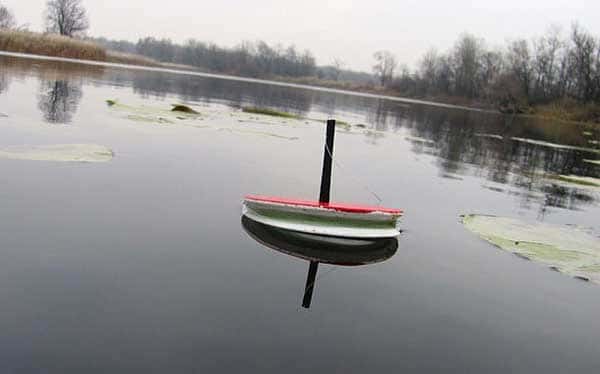
When there is no suitable one for tying, find a stick, tie a fishing line with a weight to one end, and tie a circle at the other end. Try to launch the tackle in such a way that when moving it passes the favorite places of predators. If properly equipped, during a bite the circle should turn over with its light side up, the predator will begin to go into cover along with the circle.
The task is to swim to the triggered tackle and start reeling in the line, if the pike allows it, otherwise you can release the line and repeat the attempt to bring the pike to the boat. Depending on the size of the individual, the fish gets tired quickly or slowly, giving the opportunity to unhinderedly bring itself to the fisherman, this is where it comes in handy hook. When hooking a pike, you should make a sharp jerk, use high-quality tees and there will be no problems.
Wobblers that catch 100%:
Shimano FX
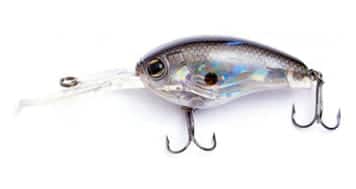
More details
Shimano FX
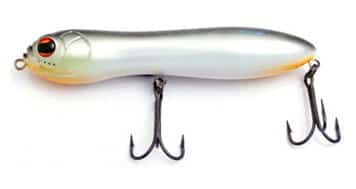
More details
Shimano FX
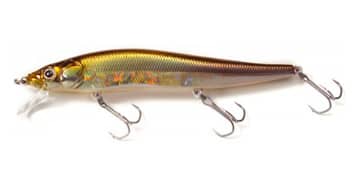
More details
Shimano FX
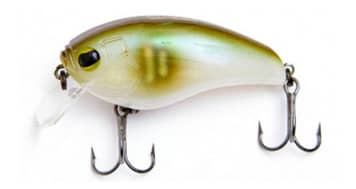
More details
You shouldn’t launch 20 circles at once:
- There are gear standards for 1 fisherman.
- It's difficult to keep track of all the gear.
To achieve success you need:
- Choose as a fishing location places where pike can ambush.
- Take into account the behavior, quality and survivability of live bait. Remember: dead baitfish are less attractive to predators.
- Don't be greedy, don't use too much gear.
- Use high-quality hooks and equipment in general; the sharpness of the hooks and the strength of the fishing line are of considerable importance.
After reading the article, the question arises, how many mugs can be used per fisherman - the answer is 5 pieces, it is not prohibited and is easy to keep track of. Buy ready-made gear, make it yourself and quickly try your luck in this exciting method of catching predatory fish.
How to catch pike with mugs
The fishing process itself is quite simple. Live bait swims in the water column at a depth set by a sliding weight suspended under a circle. The pike, having grabbed the bait, pulls the line and thereby turns the circle over, which signals a bite. The fishing line pulled out from the snap is unwound from the reel, which allows the predator not to feel the tackle and swallow the bait. The fisherman, swimming up to the overturned tackle, performs a hook with sharp movements and begins to fish. You can fish with mugs in different ways.
Important! According to the law, when fishing, no more than five circles are allowed per fisherman. In practice, with a normal bite, it is impossible to keep track of a large number.
Rafting downstream
Having chosen a promising section of the river, the fisherman places himself upstream, prepares and baits all the circles, and then places them in a line, perpendicular to the flow, with an interval of about 5 meters. Then it is located at some distance behind this line, and floats along with them, observing the bites and catching the pecked fish. The advantage of this method is that the fisherman and the mugs float at almost the same speed, not far from each other, and he does not have to move much. At the same time, he fishes a fairly large area of water.
Downwind rafting
Certain areas of the reservoir can be fished using circles driven by the constantly blowing wind. In this case, fishing begins on the windward side and moves under the influence of the wind along with the circles. This is more difficult to do, since the sail of the boat is much larger and you have to constantly row it, equalizing the speed. A floating anchor buoy helps solve this problem. This method is well used on large lakes where there is no pronounced current, but there are constant daily and seasonal winds.
Fishing with free live bait
It is used in small bodies of water without a current, ponds, small lakes or creeks. The mugs are equipped with lighter weights, allowing live bait to move more freely and pull it along with them. They are placed in an area of the reservoir free from underwater obstacles, and they gradually “scatter”, guided by live bait. In addition to bites, the fisherman must ensure that individual gear does not swim far enough and does not approach areas of the reservoir where they can get stuck.
Fishing with stationary mugs
The fisherman places the mugs in promising places by anchoring or tying them to something, and then periodically checks the installation sites in case of a bite. The fact is that stationary fastening of the gear can lead to self-cutting of the predator, which ensures the catchability of this method.
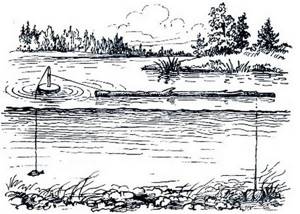
What is a “circle” tackle and how is it designed?
The fishing circle is distinguished by the simplicity of its design, but at the same time it shows quite good results when catching such a predator as pike. By its principle, the tackle resembles a pier, which can be lowered from a boat and directed either with the wind or with the current.
IMPORTANT! The “circle” is so incredibly popular because it floats on the surface of the water column without any participation from the fisherman, so you can use several of these devices at once to significantly increase your chances of a big catch.
The gear is completely independent, so the fisherman only needs to closely observe the vibrations of the circle, in the center of which there is a kind of float, and when biting, pull the fishing line or thread sharply and in time in order to catch the predator.

Description and device
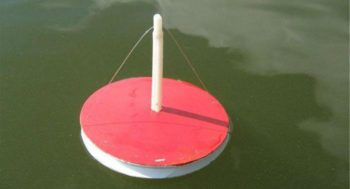
A circle, or, as fishermen also call it, a floating girder, is a circle that is about 15–20 centimeters in diameter. The thickness of the device ranges from 20 to 25 millimeters.
In the center of the circle there is a special recess on which a certain amount of fishing line is wound, and at the very top there is a slot for securing the tackle in one position and attaching it to the sinker.
IMPORTANT! There is no need to wrap the maximum amount of fishing line around the notch, as this will significantly make the tackle heavier. It is enough to wind a minimum amount of several tens of meters, which will be quite enough to regulate the depth.
The tackle itself consists of several separate parts:
- A circle in which the upper part is painted red or any other bright color, and the lower part is necessarily white.
- A mast that is installed in the central hole of the structure in such a way that the large rounded part remains at the bottom, and a thin mast with a slot for attaching a fishing line is located at the very top.
- Lines of a certain diameter.
- Hooks that every fisherman selects depending on the size of pike he wants to catch;
- A leash that takes fish with sharp teeth away from the tackle itself, thereby protecting it from premature wear.
The most simple design allows fishermen to get a very solid catch, which they are not ashamed to show off.
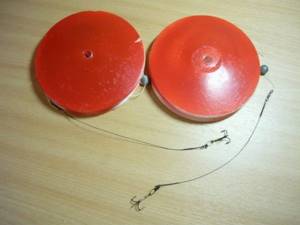
Advantages and benefits of use
The mug has only a lot of positive advantages and practically no drawbacks, which is why many fishermen prefer hunting predators using this simple method. The main advantages include:
- simplicity and accessibility of design;
- light weight and small dimensions, so it easily fits in a box with fishing tackle;
- ease of use while fishing.
You can carefully put several mugs in a separate case and not clutter up the trunk of your car with massive fishing rods.
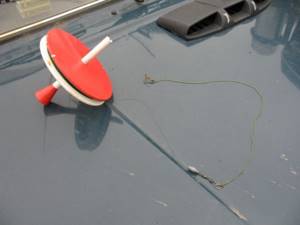
The main advantages of use include:
- Does not require constant monitoring, unlike spinning rods.
- You can place several tackles around the tray at once, and the rods will not get in the way in the boat, taking up valuable space.
- The circle floats independently on the surface of the water, so the bait in the form of live bait will be constantly in motion, which pikes like so much.
That is why every year you can see more and more fishermen who refuse spinning rods and give their preference to this particular gear.

Seasonal fishing
Depending on the season, fishing with mugs will differ. This is primarily due to external factors, changes in fishing locations and depths, weather conditions, etc.
In summer
In summer, pike, being moderately active, hunt in the upper layers of water, especially after the formation of a thermocline. It hides in thickets of algae, coastal areas with reeds and various shelters such as snags, pits, overhanging trees and bushes, etc.
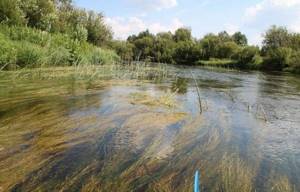
Mugs are hidden in clearings among algae
Mugs are used either by floating along such areas, or by placing them in promising places, clearings among algae and water lilies, next to snags, exits from pits and bridge piles. The disadvantages of this period are the small number of areas where you can catch pike by long-term rafting.
in autumn
In autumn, the pike bite becomes more active; it goes to depths of more than 3 meters. As the water gets colder, more and more algae-free areas appear. This allows, by floating circles, to fish many channels, move with the current along the banks with promising areas, fish holes, and other promising deep areas.
With the onset of autumn, the winds become stronger, which makes it possible to carry out long downwind rafting trips on the lakes. The increased transparency of the water helps to attract predators from a larger area.
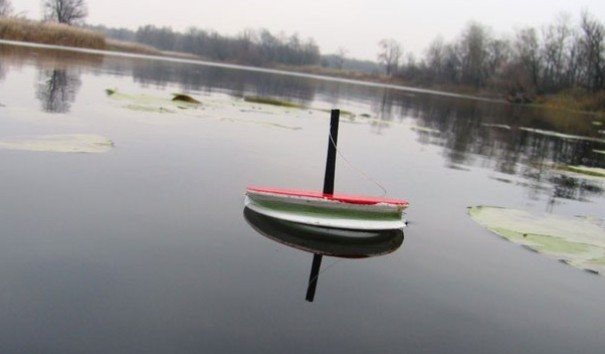
The disadvantages of autumn are worsening weather conditions, rain, fog, strong winds generating high waves. All this interferes with the normal fishing process.
Fishing tactics
If the weather is not too capricious, the sun is shining and a light breeze is blowing, then you can fish a significant part of the reservoir using floating circles without an anchor. For fishing on a windy day, stationary gear is more suitable. On the river, they can be placed above the channel edge in a checkerboard pattern, not forgetting to take into account the fishing depth. Live bait should be located above the bottom at a height of approximately 0.5 meters, and not in the water column, and especially not at the surface. In cold autumn water, the pike does not rise to the top; it stands at the drop-off and waits for small fish. In closed reservoirs, promising areas are chosen for installing circles, where the predator was well caught on a spinning rod in late summer and early autumn.
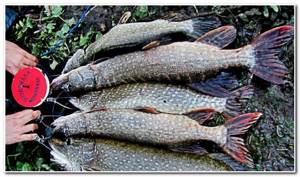
After installation, the fisherman swims 40 meters to the side and goes ashore. There is no need to pull the boat out of the water, since prompt action is important in this type of fishing. One of the circles can work (turn over) at any moment, and you will need to quickly swim to it. You should approach the “shifter” by inertia, with the oars raised, otherwise the frightened pike will try to spit out the bait or rush with it into the nearest thickets. When the circle is in your hands, you need to make a sharp hook, after which you can begin to fish out the prey.
Pike bite differently. The hungry one grabs and swallows the bait instantly, while the well-fed one first plays with it, so the process is somewhat delayed. In any case, after the mug is triggered, you should not rush, especially if it is loaded with large live bait. It is better to hook after a 20-second pause, and if you are using a single hook, you can wait longer. Often the predator that has grabbed the fish leaves this point, which is signaled by the unwinding line. Then she stops. It is at this moment that you should strike.
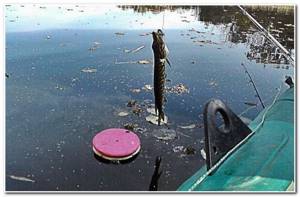
Fishing in different bodies of water
Fishing with mugs in various types of reservoirs has its own characteristics, determined by the current, relief, water area and a number of other factors. All this must be taken into account when choosing a fishing technique and equipping tackle.
On the river
The peculiarities of fishing on the river include the constant speed of the current, and the pronounced constancy of the bottom topography. It manifests itself in greater depth in the middle of the channel, decreasing near the banks, with a steeper right bank and a flatter left one. All this allows you to systematically fish large sections of the riverbed, rafting downstream.
The disadvantages of such conditions include the need to overcome the current when returning to their original positions. In addition, in case of unforeseen situations, the river can carry away your gear. It is not very convenient to use stationary mugs in the current.
On the lake
On lakes, currents are usually weak, so the main factor influencing the movement of circles is the wind. But its impact is not as predictable as the flow of a river. In addition, the bottom topography in lakes can also be quite unexpected, so when fishing in such reservoirs, the depth must be clarified in advance.
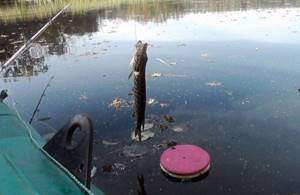
Lakes, especially small ones, allow fishing with free circles. In addition, it is more convenient to place them permanently here. The disadvantages of large lakes include high waves, which can interfere with fishing.
How to properly equip mugs for catching pike with live bait
An inexperienced fisherman is capable of inflicting a fatal hook on a fish through illiterate actions, which will lead to a decrease in bites. There is no universal method of baiting; first of all, the fisherman is guided by his habits, in addition, it depends on the fishing conditions. So, catching pike with mugs and bait with live bait.
- Back puncture
. This is the most common method for catching pike with a circle. They pierce the back just below the upper fin, being careful not to touch the spine. By the way, not all types of fish can be pierced with a regular tee. For bleaking, a special hook is used, in which one tip is smaller and thinner than the others, which allows you to prolong the viability of the fish. - Threading through gills
. With this method, a double hook is usually used. The clasp is removed from the leash, the hook is secured with a loop. When planting, the end of the leash is threaded through the gills and brought into the mouth. After fixing the hook, the leash is pulled until the shank is in the fish's mouth. Catching pike with live bait in circles is effective in this case. However, this method is almost impossible to use with a soft leash, so it is advisable to use a crochet hook. - Lip piercing
. The method is practiced when fishing for pike with circles in the current and is popular because the fish are minimally injured. A very fast method of baiting, but it is easy to lose the bait when attacked by a predator. - Tail attachment
. With this method, absolutely no injuries are caused to the live bait fish, since the area near the tail fin is first tied with a thread, under which the hook tip is threaded.
How to plant a cut in this case depends on many factors - what predator is being hunted, fishing time, and the passivity of the fish. For example, to interest perch or pike perch, live bait is attached under the upper fin. To know how to catch pike with mugs in the summer, for this purpose the fish is baited under the gills, since when it starts to swallow it, it will no longer be possible to spit out the hook.
Tips for beginners
- When preparing to fish with mugs, find out in advance the depths, bottom topography and promising places.
- As live bait, you need to use fish that are typical for a given reservoir; it is better to choose tenacious species like gudgeon or crucian carp.
- When rafting behind the circles, it is better to place them in a line or arc, being behind them, in the middle, in order to see and reach everyone in time.
- The distance between the circles depends on many factors, the speed of their movement, the depth of fishing, etc., so that the gear does not get tangled, you can keep track and be in time for all of them.
- In strong currents they fish either with stationary circles, or when rafting they fish with one or two.
- When biting, you don’t need to hook immediately; let the pike thoroughly grab the bait.
What does a circle look like?
Externally, it is extremely simple - a round disk made of light, buoyant material. There is a small groove along the perimeter into which the wound fishing line is placed. A hole is made in the center of the disk into which a small pin is inserted - one end is thin, and the other is thicker and rounded. The two edges of the disk have different colors - this makes it easy to notice a bite even if fishing with a circle is carried out in low light conditions, for example, early in the morning or late in the evening. The rest of the equipment resembles a rig - a strong fishing line and a large hook, preferably an anchor, and in some cases also a weight. Experts divide them into two types - moored and drifting. The discs themselves are no different, but the equipment has slight differences.
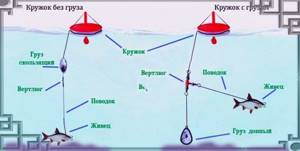
Drifting
Better suited for fishing in the fall. Pike at this time is more passive - having gained enough fat, it calmly tolerates a drop in water temperature in anticipation of winter, leads a sedentary lifestyle and can stand in the depths for hours. Drifting mugs will be a good choice; they are not equipped with a load, and therefore live bait freely drags them from place to place. Consequently, the likelihood that he will be close to a pike or pike perch increases - predators will accurately react to the appearance of prey in their immediate vicinity. But it is not recommended to install several drifting gear on small ponds - they can get mixed up with each other.
To learn more:
Peculiarities of rotan biting in October
Moored
In summer or on a small lake it is better to fish with stationary mugs. They differ from those described above only in the heavy load. It is installed on an additional leash so that it is 20-40 cm above the hook. In early and mid-summer, pike are very active; at dusk they swim around the pond, attacking any suitable prey. A large load prevents bait fish from dragging the tackle from place to place, therefore reducing the risk of entanglement - several circles can be installed on a small body of water, which will increase the likelihood of successful fishing. An additional plus is that even if the bait falls asleep, it will not float up with its belly, but will be kept at the required depth. Predators often happily peck at dead bait. Which option to choose for a particular fishing trip is up to you to decide, taking into account the time of year and the characteristics of a particular body of water.
Underwater video: Pike grabs the bait
Common mistakes
- The number of circles should not be excessive; their excess leads to tangling, empty bites and loss of gear.
- The length of the fishing line on the circle should be slightly greater than the maximum depth of the reservoir at the fishing site, so a large predator will not pull it under water.
- You need to approach the circle so that the fishing line with the fish does not fall under the boat.
- When fishing, especially for large pike, do not put the circle in the boat, leave it in the water, and choose the line yourself, in the event of a sharp jerk of the predator, this helps to avoid getting lost.
- When fishing, the fishing line must always be taut, otherwise the predator may get away.
- Do not make the hook while standing; you may lose your balance and fall out of the boat.
Two options for circles
Drifting mugs
Active autumn pike can be caught on drifting circles that move across the pond in the direction the wind blows. Their advantage is that they themselves “search” for prey, swimming a certain distance. On a wide lake, you can set sail with a dozen of these products with an interval of 20-30 meters between them, and thus fish a decent area. If not one, then the other will definitely be bitten by a pike.
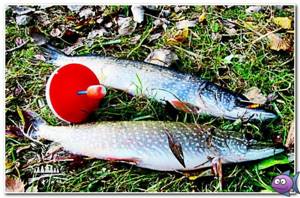
If the predator is too passive, then it is more advisable to use another type of this gear - a stationary circle. This type is equipped with a sinker, the task of which is to hold the tackle in one place. The live bait on the moored circle is located at one point. He behaves smartly, tries to free himself, tirelessly cuts circles and thereby causes aggression in the predator. Even if the pike is not hungry, it still will not tolerate such behavior in its territory and will definitely attack the fish. Sometimes, after grabbing it, she spits out the impudent baitfish, but at the same time the sharp hook clings to the edge of her mouth and a self-cut occurs.
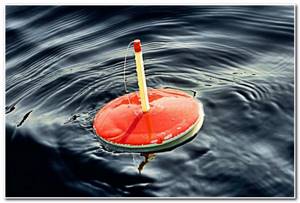
Anchored circles
Anchored circles are placed in pike mooring areas: near reed walls, under bushes growing in the water, next to small islands of vegetation that serve as shelter for it. This type of gear is perfect for fishing on ponds and small lakes, where freely drifting circles literally have nowhere to turn around. They constantly have to be collected in shallow areas close to the shore, where they are washed away by the waves, and thrown in again. This takes a lot of time, but is of little use, because the pike, like any other fish, is scared by the boat. And at a depth of less than 1.5 meters, the capture of a predator of decent size is unlikely; most of the fish that are caught are squirrels weighing up to half a kilo.
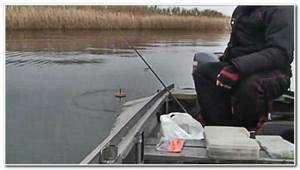
Features of fishing with mugs in autumn
As the water temperature decreases, pike activity increases. The period of autumn zhora lasts almost until the appearance of ice. Fish are actively gaining fat reserves for the winter. Therefore, she is indiscriminate in her diet. At this time, the predator can rush at prey from cover and peck in open water. The autumn season is notable for the fact that rarely does a fisherman go home without a catch. During this period, there is a high probability of catching a trophy specimen.
Mugs are also used for winter fishing. Most often they are installed in small openings and holes. To do this, use loaded or moored gear to avoid demolition. When winter fishing, you must remember to maintain safety when on ice.
How to prepare for fishing using circles
Before fishing in this way, you need to conduct a study of the state of the bottom of the reservoir in which you are going to do this. For this purpose you will need a device such as an echo sounder. Although you can limit yourself to jig probing.
To drag caught fish into your boat, you will need a landing net and a hook. You can't do without reinforced gloves , because if you decide to do without this attribute, you risk cutting your hands on the sharp fins of the predatory fish you are going to hunt.
For fishing to be successful, you will have to stock up on live bait , since pike is a predator and will only bite on small, tasty fish. Suitable live bait include: rotan, roach, rudd, bream, crucian carp and gudgeon.
The fish that your pike will bite on will need to be kept in something during transportation and storage. To do this, you will need to use a canoe with a grate, thanks to which you will be able to remove the bait without putting your hands in the water.
You can use not only live fish as bait , but also dead ones . Just for the pike to bite on it, you need to cut its sides. Blood will flow out through the cuts and thus the dead fish will attract your potential prey.
We also recommend reading:
Budget spinning reels Riobi Exiya Model range of Salmo wobblers and the Salmo Hornet catalog Features of crucian carp killer tackle and how to make such equipment Diagram of how to learn how to tie a hook to a fishing line
In addition to all of the above, you will need leashes with hooks in reserve and an extractor with which you will remove hooks from caught prey.
How to make a circle with your own hands
It is convenient to purchase this simple fishing tackle in specialized stores. But many people prefer to make it with their own hands; a homemade product works no worse than a factory-made analogue and is completely free - it is usually possible to select the material without difficulty. You can make just such a circle for a pike that will meet all the requirements - in color, size and shape. The creation process is as simple as possible:
- Cut a disk 2-3 cm thick and about 15-20 cm in diameter from foam plastic or cork.
- Make a small hole in the center.
- Prepare a piece of plastic or wooden cylinder of variable cross-section so that it fits the diameter of the hole. Make a small notch in the upper part, allowing you to fix the fishing line in it.
- Cut a recess of about 1 cm along the side edge for winding the fishing line. You can process it with a file or fine sandpaper to avoid burrs and irregularities.
- Paint one edge (top) white and the other (bottom) red.
To learn more:
Tropical and pink loach: barometer fish
Thanks to this coloring, you can always determine whether the circle has turned over, which means you will understand whether there was a bite.
In summer
In summer, pike is very active, it is in constant motion and very often hunts from ambush near reeds or thickets of aquatic vegetation. The fact that a predator is hunting at the fishing site can be evidenced by the fry splashing on the surface. Catching pike with mugs in the summer will bring great results in a reservoir where there are abundant thickets of water lilies.
You can try your luck by installing mugs
in the windows of aquatic vegetation
.
Those who fish for the first time know that the amount of oxygen in the water depends on the depth. The reason for this is the temperature stratification of water, which greatly affects the fish. Oxygen comes from the air and from algae, which release life-giving gas in the light.
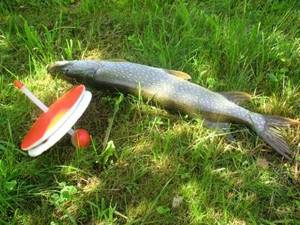
But this phenomenon is not observed everywhere, with the exception of the upper layers of water. If you lower live bait into the top layer of water, then the lack of oxygen will force it to stop moving after 10-15 minutes and you will no longer have live bait, but a dead fish.
Experienced fishermen recommend fishing for pike in the summer at depths of about 6 meters, as it perfectly senses favorable habitats. It is best to lower the bait into the water gradually and, based on its behavior, adjust the fishing depth.
Particular attention should be paid to the features of the bottom topography. Tall bushes, stumps, ravines, old river beds - all this can serve as shelter for large pike. But there is another side to the coin - this can interfere with the free movement of the circle.
Equipment mug
The mug rig for catching toothy fish is lightweight and easy to use and manufacture.
The main parts of this type of equipment are:
- The disk of the circle, which has special notches to preserve the fishing line and a hole for the antenna;
- A stick with a hole for threading monofilament thread;
- Line with a diameter of 0.3-0.5 mm;
- Weight;
- Nozzle for further securing live bait;
- Leash.
fishing line
To equip a homemade circle, you must first prepare a fishing line with a diameter of 0.3-0.5 mm.
Moreover, you should definitely know the depth of the reservoir where you are going to fish. Since experts recommend making a small supply of monofilament.
So, it is advised to make the fishing line longer by 6-8 m from the depth of the fishing spot. Most often, 15-20 m of fishing line is completely enough.
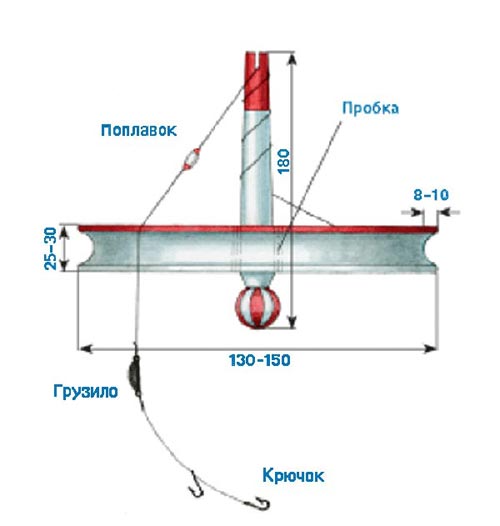
In the case when catching a toothy predator will be done at great depths, it is recommended to attach a small piece of foam to the fishing line.
You can also use rubber. This will allow you to independently adjust the fishing depth.
Sinker and Hook
A sliding weight weighing 15 g is used as a sinker.
You can use any pike hook or treble hook. Here the opinions of experts and amateurs differ. But most often they decide to use a double hook.
Nozzle
Most often, circles are caught using live bait.
The best bait options for this method of fishing for toothy predators are:
- rudd;
- loach;
- ruff;
- perch;
- perched water;
- silver bream;
- rudd;
- gudgeon and much more.
